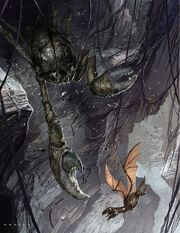
The Deplector, Deplector, is a large, terrestrial crab from the chasms of Skull Island. Hanging like apes from the boughs of giant stone trees, these crabs (along with rat monkeys) lean out from the walls of the pits to seize passing prey. It measures 4-8 feet long. A close relative is the smaller Abyscidis.
Blind Deplectors are giant, unique, terrestrial crabs that live in the cracked and crumbling rock walls of the abyssal fissures that spider web the shattered island. Hanging in place, with their enormous chelae folded almost Mantis-style in front of them, they wait for small prey to pass the mouths of their holes. Their long antennae are sensitive to vibrations in the air, enabling them to pinpoint prey despite lacking eyes.

The most common prey are the tiny vultursaurs that fly in thick flocks through the chasms at night, hunting moths. The hunters will find themselves prey, snatched from the air by the switchblade chelae of the Deplectors in the canyon walls. Despite a single crab taking up to a dozen of the little flying dinosaurs in a night, they make barely a dent in the vast vultursaur numbers.
When lunging, Deplectors throw all their weight into the attack, relying on elastic and stringy excretions from their abdomens to tether them to the rock, preventing a fall. At will, they can sever these sticky anchor cords to move about freely.
Mature females lay bundles of several hundred eggs in the back of their caves. The tiny white young hatch and disperse into the chasm en masse.

Of all the species on Skull Island, Deplectors exhibit the most extreme sexual dimorphism, with mature males a speck next to the giant females. The carapaces of tiny female larvae darken and harden with successive molts as they grow. A mature female can be up to eight feet in length, with chelae extending a further six feet and antennae as long as 12 feet. Mature males, however, remain looking like larval forms: small, pale, soft-shelled, and defenseless. They colonize the nurseries at the rear of the females’ caves, fertilizing eggs in exchange for the safety provided by their enormous landladies.

